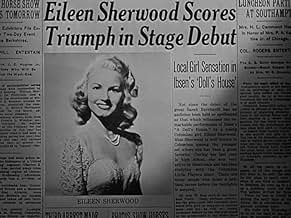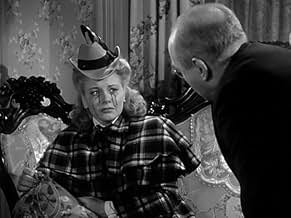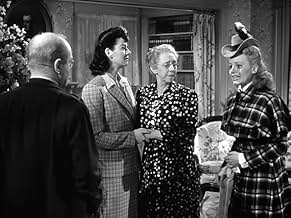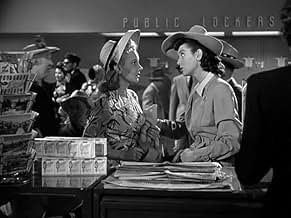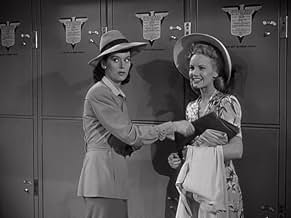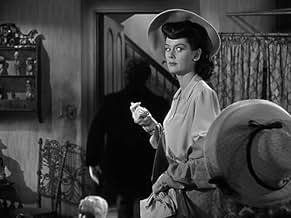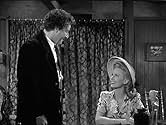CALIFICACIÓN DE IMDb
7.0/10
1.9 k
TU CALIFICACIÓN
Agrega una trama en tu idiomaTwo sisters move from Ohio to New York with hopes of stardom.Two sisters move from Ohio to New York with hopes of stardom.Two sisters move from Ohio to New York with hopes of stardom.
- Dirección
- Guionistas
- Elenco
- Nominado a 1 premio Óscar
- 2 premios ganados y 1 nominación en total
Jeff Donnell
- Helen Loomis
- (as Miss Jeff Donnell)
George Adrian
- Cadet
- (sin créditos)
Kirk Alyn
- Portuguese Merchant Marine Cadet
- (sin créditos)
Don Barclay
- Drunk
- (sin créditos)
Richard Bartell
- Lothario in Bus Terminal
- (sin créditos)
Opiniones destacadas
Rosalind Russell was one of the finest comediennes in the American movies, and this in a period which saw the likes of Claudette Colbert, Carole Lombard, Jean Arthur, Ginger Rogers, Irene Dunne, Katharine Hepburn and others. Russell was a rarity: though all the others often played dizzy women, in her comedies, Russell always played smart, hard-edged career women (the exception was her first major comedy role, as the catty Sylvia in THE WOMEN).
At a time when HANNAH TAKES THE STAIRS is set to open, with its lackadaisical heroine pursuing a writing career as she tries to make sense of her romantic entanglements, it behooves us to remember MY SISTER EILEEN, which (when it was filmed in 1942) is the prototype, as the two Sherwood sisters (Ruth, played by Rosalind Russell, and her younger sister Eileen, played by Janet Blair) come to New York City to try their hands at writing (for Ruth) and acting (for Eileen). The slapstick annoyances, the charmingly maladroit Greenwich Village denizens (part ethnic, part "bohemian"), the stereotypical romantic encounters, all make for a charming entertainment. In the wake of the sexual frankness of HANNAH TAKES THE STAIRS, MY SISTER EILEEN might seem dated, but it's a lovely reminder of the wit and the humor of the generation growing up during World War II, when women were (again) finding new possibilities in the workplace, but still had the same problems finding proper dates.
At a time when HANNAH TAKES THE STAIRS is set to open, with its lackadaisical heroine pursuing a writing career as she tries to make sense of her romantic entanglements, it behooves us to remember MY SISTER EILEEN, which (when it was filmed in 1942) is the prototype, as the two Sherwood sisters (Ruth, played by Rosalind Russell, and her younger sister Eileen, played by Janet Blair) come to New York City to try their hands at writing (for Ruth) and acting (for Eileen). The slapstick annoyances, the charmingly maladroit Greenwich Village denizens (part ethnic, part "bohemian"), the stereotypical romantic encounters, all make for a charming entertainment. In the wake of the sexual frankness of HANNAH TAKES THE STAIRS, MY SISTER EILEEN might seem dated, but it's a lovely reminder of the wit and the humor of the generation growing up during World War II, when women were (again) finding new possibilities in the workplace, but still had the same problems finding proper dates.
Abner! Abner! yup, that's George Tobias from "Bewitched" behind the wig and over-sized mustache playing the bushy/pushy artist and landlord in this first film version of "My Sister Eileen". Rosalind Russell and Janel Blair are sisters who come from Ohio to the big city to find fame and fortune in New York. There are some clever lines, mostly given to Russell, but it must be the direction of Alexander Hall holding this back. The Three Stooges make an appearance, and a very flat-line Brian Aherne. He keeps stepping out of the woodwork to tell Ruth (Russell) that her stories will or will not be published. Viewers will recognize Donald MacBride as the neighborhood cop, trying to keep things under control. Gordon Jones is the out of work muscle guy from upstairs, married of course, since we're well into the Hays Code by this time. He always seems to play the wrestler, the truck driver, and people named "Tex". The girls have many adventures, but the Portuguese navy is involved, and for some reason, they put Eileen (Blair) in jail, which doesn't really make sense, but you have to buy into it. It probably made more sense before it was all whitewashed for the audience. The basic story must have good footings, since the film has been remade, and it was even turned into a TV show in the 1960s. Janet Blair, who had the least experience in films at the time, turns in the best acting performance. Interesting note- Frank Quine, who had played Lippincott in the 1942 film version, directed the 1955 remake starring Janet Leigh, Jack Lemmon, and Betty Garrett. Haven't seen that one yet, but it must have been pretty good, since that one made it to video. and the 1955 version was a musical! one odd connection - the 42 version has George Tobias, and the 1955 version has Dick York, both would end up on the TV show "Bewitched"
It's a circus, but you don't need an admission ticket. You can even peek in from the street and catch all the antics on your way to work. It's Ruth and Eileen's sub-level flat, and rents for only $48 a month with open grillwork onto a chaotic Greenwich Village street scene. Are these two ambitious Mid-western sisters ready for a pro-football player who sleeps over, a fast-talking landlord who paints like a Dodo bird, and a mysterious stranger who walks in and refuses to leave, Then there's the battalion of Portuguese naval cadets who mistake the flat for a dance studio. It's all part of this wacky, fast-paced take on Life in the Big City.
It's all good, innocent fun of course with a tempo that seldom falters, and when things do slow, there's always an underground jolt to mix it up again. Naturally, Rosalind Russell as the caustic older sister gets all the good throw-away lines, while Janet Blair as Eileen gets all the wolf whistles. Then there's the assorted characters-- Gordon Jone's trademark good-natured galoot, George Tobias' fractured ethnic type, and Chick Chandler's silent stranger more creepy than humorous. And, of course, no urban scene of the day would be complete without the bulldog-face of Donald McBride as the ever cranky cop. Together, they turn the flat into a stopover on the way to the funny farm. I expect more than a few Mid-Westerners packed up for New York hoping to get a share of madcap city life.
On a more serious note, the movie was made at a time when the "common touch" was being celebrated in popular culture. After all, it would take a combined national effort to defeat the Axis powers. So, it's not surprising that many movies celebrated the America of the "melting pot", complete with ethnic types, blue-collar characters, and frequent references to Brooklyn, the symbol of the melding.
Anyway, it's still a fun movie even if some skits do strain a bit. I guess the moral is that no city is too big for the talented. And especially, for the shapely. Then too, make sure to stick around for a very last scene that could not be more inspired or appropriate.
It's all good, innocent fun of course with a tempo that seldom falters, and when things do slow, there's always an underground jolt to mix it up again. Naturally, Rosalind Russell as the caustic older sister gets all the good throw-away lines, while Janet Blair as Eileen gets all the wolf whistles. Then there's the assorted characters-- Gordon Jone's trademark good-natured galoot, George Tobias' fractured ethnic type, and Chick Chandler's silent stranger more creepy than humorous. And, of course, no urban scene of the day would be complete without the bulldog-face of Donald McBride as the ever cranky cop. Together, they turn the flat into a stopover on the way to the funny farm. I expect more than a few Mid-Westerners packed up for New York hoping to get a share of madcap city life.
On a more serious note, the movie was made at a time when the "common touch" was being celebrated in popular culture. After all, it would take a combined national effort to defeat the Axis powers. So, it's not surprising that many movies celebrated the America of the "melting pot", complete with ethnic types, blue-collar characters, and frequent references to Brooklyn, the symbol of the melding.
Anyway, it's still a fun movie even if some skits do strain a bit. I guess the moral is that no city is too big for the talented. And especially, for the shapely. Then too, make sure to stick around for a very last scene that could not be more inspired or appropriate.
ROSALIND RUSSELL was always at her best in comedies and here she had a role that got her an Oscar nomination for Best Actress in 1942--and it's easy to see why. She's downright hilarious as the gal from Ohio with writing ambitions and a pretty blonde sister (JANET BLAIR) with a penchant for attracting men and trouble.
All the wacky situations stem from their Greenwich Village basement apartment which seems to have more visitors than Grand Central Station. It's all exaggerated fluff, but it works, thanks to a fine cast and sterling performances.
RICHARD QUINE and GORDON JONES do repeats of their Broadway roles, and DONALD MacBRIDE as a policeman who wants quiet on his route is hilarious. JUNE HAVOC makes a brief appearance as a medium who used to live in the girls' apartment. GEORGE TOBIAS, as the opportunistic landlord with the Greek accent, is at his funniest in a colorful supporting role.
My favorite moment is the conga sequence with Russell and Blair trying to get rid of sailors who don't speak a word of English, creating a disturbance that lands Blair in jail. Janet Blair is pleasant as the blonde bombshell but it's Russell who milks the most out of her role and gets all the laughs. She's terrific.
BRIAN AHERNE does what he can with the role of the talkative editor, but it's not much of a part. Still, he adds a certain debonair charm to the role.
Summing up: Notable chiefly as a terrific vehicle for Russell's unique brand of comic talent.
All the wacky situations stem from their Greenwich Village basement apartment which seems to have more visitors than Grand Central Station. It's all exaggerated fluff, but it works, thanks to a fine cast and sterling performances.
RICHARD QUINE and GORDON JONES do repeats of their Broadway roles, and DONALD MacBRIDE as a policeman who wants quiet on his route is hilarious. JUNE HAVOC makes a brief appearance as a medium who used to live in the girls' apartment. GEORGE TOBIAS, as the opportunistic landlord with the Greek accent, is at his funniest in a colorful supporting role.
My favorite moment is the conga sequence with Russell and Blair trying to get rid of sailors who don't speak a word of English, creating a disturbance that lands Blair in jail. Janet Blair is pleasant as the blonde bombshell but it's Russell who milks the most out of her role and gets all the laughs. She's terrific.
BRIAN AHERNE does what he can with the role of the talkative editor, but it's not much of a part. Still, he adds a certain debonair charm to the role.
Summing up: Notable chiefly as a terrific vehicle for Russell's unique brand of comic talent.
Ruth McKenney's series of autobiographical articles about siblings from Columbus, Ohio relocated to wacky Greenwich Village was initially turned into a play before this movie version (it later went back to the stage as the musical "Wonderful Town", winning a Tony award for Rosalind Russell), and in 1955 was filmed again as "My Sister Eileen" with the songs. Russell appears here as Ruth (the smart, savvy sister who longs to be a writer) and Janet Blair is sister Eileen (the pretty blonde with hopes of becoming an actress). They move into the noisiest hovel in New York, with a steady stream of foot-traffic and neighbors who barge in without knocking. Some of these characters are colorful, though the comic craziness is pitched a little high, and everyone overacts (cheerfully). Russell (who got an Oscar nomination for her dryly bemused performance) sports an awful potato-chip hairstyle which must have been all the rage in 1942; her double takes and facial exaggerations are often very funny, and she plays well off Blair (they take turns playing the jester and the straight-face). Is it ridiculous and over-the-top? Absolutely. But when the results are this friendly, it's useless to complain. **1/2 from ****
¿Sabías que…?
- TriviaThe movie is based on the real-life experiences of Ruth McKenney, and her sister Eileen. In 1934, Ruth and Eileen McKinney moved to New York from Columbus, Ohio. They rented a $45-a-month basement apartment at 14 Gay Street in Greenwich Village, above the Christopher Street subway station. Ruth wrote about their eccentric neighbors and the trials of living in a basement apartment in her column titled, "My Sister Eileen," which was published in "The New Yorker" (called "The Manhatter" in the movie). As seen in the film, "The New Yorker" editor Harold Ross was at first reluctant to publish Ruth McKinney's columns, preferring to keep his magazine a "High Society" publication, but he eventually relented. Ruth's columns were gathered in a book, "My Sister Eileen," which was published in 1938. Eileen McKinney moved to Los Angeles, where she married novelist and screenwriter Nathanael West (author of the perennial Hollywood novel, "The Day of the Locust"). Unfortunately, Eileen McKinney and Nathanael West were both killed in a car accident in Los Angeles on December 22, 1940, only four days before they were scheduled to attend the Broadway opening of the play, "My Sister Eileen." Ruth McKinney died in 1972 at age 60.
- ErroresWhen Bob puts Ruth in the taxicab outside of the police station, the shadow of the boom mic can be seen moving across the hood of the cab.
- Citas
'The Wreck' Loomis: [holding an iron] Which way do you want the pleats turned?
Ruth Sherwood: Toward Mecca.
- ConexionesReferenced in Acropolis Now: My Sister Aphroula (1990)
- Bandas sonorasRamblin' Wreck from Georgia Tech
(uncredited)
Written by Billy Walthall, Frank Roman, Charles Ives and Michael Greenblatt
Sung by Gordon Jones
Selecciones populares
Inicia sesión para calificar y agrega a la lista de videos para obtener recomendaciones personalizadas
- How long is My Sister Eileen?Con tecnología de Alexa
Detalles
- Fecha de lanzamiento
- País de origen
- Sitios oficiales
- Idioma
- También se conoce como
- My Sister Eileen
- Locaciones de filmación
- Productora
- Ver más créditos de la compañía en IMDbPro
- Tiempo de ejecución1 hora 36 minutos
- Color
- Relación de aspecto
- 1.37 : 1
Contribuir a esta página
Sugiere una edición o agrega el contenido que falta


